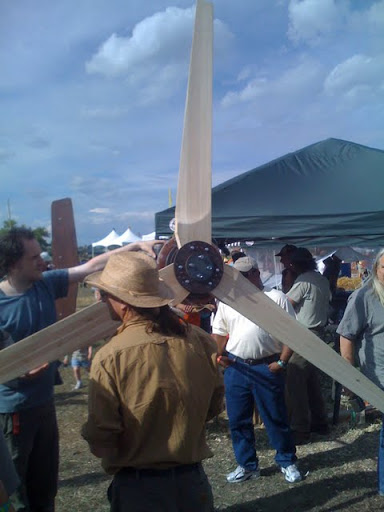Homebrew Wind Power, by Dan Bartmann and Dan Fink, is really the best book I have found for wind turbine building. Actually, it’s one of only two books I have found on the subject. The other is How To Build a Wind Turbine, by Hugh Piggott. While this is a great book as well, it doesn’t go into as much detail and the tubine design it promotes is not as elegant and simple for an individual to build in a small shop. There are a lot of other articles , how-tos, and websites out there on the subject as well, but these are the only two complete sources, and it is obvious that these guys have spent years perfecting their plans.
The majority of the Homebrew Wind Power book explains how to build the 10 foot diameter horizontal axis wind turbine that I am building. Below you can see a picture of the one I helped build at the Sustainable Living Festival last year. They rate this turbine design at somewhere between 700 and 1000 watts, which is comparable to any commercial wind turbine of the same size. I think they rate this turbine at 1000 watts at high winds like 20 miles per hour. This mean it realistically will generate about 100 kwh a month at a site with an average of only 10 miles per hour winds. For reference, the average household in the US uses 750 kwh a month. So this is pretty significant amount of energy, especially if you are below average in your energy usage.

They split the task of building this turbine into a bunch of chapters that you can follow step by step: Frame, Tail, Magnet Rotors, Stator, Rectifier, Alternator Assembly, Blades, Rotor Assembly, and Tower. These guys are really good at explaining everything you need to know about each step in the process, even if you have very little experience with this sort of thing. They designed this turbine specifically to be build by non-technical people and with freely available raw materials. The most complex parts of this entire project involve welding and casting parts in polyester (polyester, vinyl and/or epoxy) resin.
Anyway, I will start blogging about the steps I have completed in the next journal entry.
